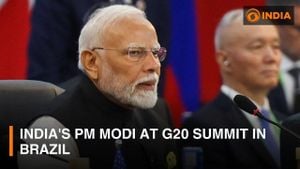Delhi is engulfed by hazardous air pollution, with the Air Quality Index (AQI) hitting alarming levels, some readings even reaching 500, indicating severe plus conditions. Environmental authorities are scrambling to address the worsening situation, prompting various emergency measures including school closures and vehicle restrictions as part of the Graded Response Action Plan (GRAP) Stage IV. The city has recently seen its air quality deteriorate significantly, particularly notable by the fact it recorded AQI values surpassing 400 for consecutive days.
The increased levels of pollution have led to serious health concerns for residents, especially for vulnerable populations such as children, the elderly, and those with pre-existing respiratory conditions. With the weather conditions aggravate the smog, clouds covering the city, Delhi residents are facing the very real consequences of this environmental crisis.
Officials, including Delhi’s Environment Minister Gopal Rai, have begun advocating for cloud seeding—an artificial rain technique to alleviate the severe smog conditions. Rai has called for the urgent convening of meetings with Union Environment Minister Bhupender Yadav to discuss the feasibility of this solution. He pointed out the dire need for immediate action, urging the central government to facilitate cloud seeding to combat the high levels of pollution hanging over the national capital.
“The entire North India is gripped by air pollution, and artificial rain may be the only option to disperse this toxic haze,” Rai said during press conferences, emphasizing the gravity of the situation which he labeled as nothing short of medical emergency.
There’s been mounting criticism directed at the central government for its delayed actions concerning pollution control, with several requests for meetings on cloud seeding remaining unanswered. Rai criticized the federal environment authorities for not convening discussions earlier, stating, “Despite multiple requests, no meeting has been held to explore cloud seeding as an option.”
The Delhi government has already enacted multiple policies to address the crisis: banning older vehicles, restricting commercial trucks from entering the city, closing schools temporarily, and enforcing staggered office hours to limit commuter traffic. Despite these efforts, the city still grapples with pollution levels far above the World Health Organization's recommended safety limits.
Meanwhile, experts from various environmental organizations warn of the implication of not taking immediate action. They suggest additional measures beyond short-term responses. Anumita Roychowdhury, one such expert, emphasizes, “While the immediate response is to avoid adding to the pollution problem, true change requires addressing major pollution sources seriously.”
Measures encouraged by experts include reducing vehicle use, opting for public transportation, and minimizing outdoor activities. Dr. Gufran Beig, associated with the System of Air Quality Forecasting and Research, stresses the importance of wearing masks outdoors and ensuring good ventilation indoors. He cautions the residents against the misconception of closing windows to keep pollution at bay, asserting the necessity of air circulation within buildings.
The persistent air quality crisis has prompted legal action as well. The Supreme Court has stepped in, instructing authorities to maintain GRAP Stage IV restrictions regardless of fluctuations below the 450 AQI mark, highlighting the inadequacies of prior pollution control implementations.
The court's directive came following public outcry and health advisories urging all residents to remain indoors and wear N95 masks when venturing outside. It has been previously noted how adverse weather conditions—especially lack of wind—have aggravated smog conditions, leading to stagnant pollution levels.
The discussions surrounding cloud seeding have opened up debates on weather modification techniques. Proponents argue it presents a necessary action amid acute smog episodes. Cloud seeding involves dispersing chemicals like silver iodide or potassium iodide to encourage moisture uptake within clouds, potentially leading to localized rain. Historically, this approach has sparked interest as emergencies arise, but it remains controversial due to environmental and ethical concerns.
“Cloud seeding is not the end-all solution,” cautions Dahiya, urging long-term strategy enhancement alongside emergency actions like cloud seeding. Overall, there's consensus among officials and experts alike on the need to cultivate public awareness about air quality issues and empower residents to hold the government accountable for pollution control actions.
Social media campaigns and community efforts may bolster efforts; according to experts, building public pressure can compel policy change and implementation of necessary pollution controls. Community-driven initiatives encouraging local citizens to adopt environmentally friendly practices might also help mitigate the consequences of poor air quality.
The situation became dire as temperatures drop, and winter often exacerbates the effect of existing pollutants, bringing colder air and fog trapping emissions at ground level. Such meteorological patterns have historically cornered Delhi residents during winter months, wherein they endure the brunt of significant air quality issues.
Another doctor from the All India Institute of Medical Sciences echoed the sentiment of caution this time of the year. “Respiratory diseases will see increased hospital visits under these air quality conditions,” they remarked, reiterative of both the short- and long-term impacts of pollution on health.
The smog engulfing the city isn’t just inconvenient; its composition poses real and specific risks. Pollutants related to vehicular discharges, stubble burning, and emissions from construction sites create conditions inviting respiratory illness and other severe health conditions. Initiatives to improve the overall urban planning and regulatory frameworks to monitor air pollutant sources have been suggested by health officials to tackle the issues going forward.
Each passing day without decisive action compounds the issue, and as the winter progresses, residents brace for the challenges posed not merely by the cold, but by the air quality as well. Immediate actions, continued accountability, and public engagement may yet provide the foundational framework needed to address the air quality crisis plaguing Delhi.



